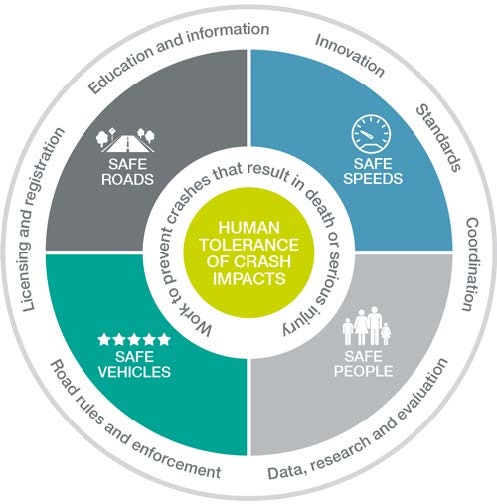Road Safety Strategy

Safe System principles
The National Road Safety Strategy is based on the Safe System approach to improving road safety. This involves a holistic view of the road transport system and the interactions among roads and roadsides, travel speeds, vehicles and road users. It is an inclusive approach that caters for all groups using the road system, including drivers, motorcyclists, passengers, pedestrians, cyclists, and commercial and heavy vehicle drivers. Consistent with our long-term road safety vision, it recognises that people will always make mistakes and may have road crashes—but the system should be forgiving and those crashes should not result in death or serious injury.
Key inputs to the Safe System are:
- using data, research and evaluation to understand crashes and risks
- developing road rules and enforcement strategies to encourage compliance and manage non-compliance with the road rules
- managing access to the road through licensing drivers and riders and registering vehicles
- providing education and information
- being open to and seeking innovation
- developing standards for safe vehicles, roads and equipment
- good management and coordination

The Safe System approach was adopted in Australia during the period of the previous national strategy, through the National Road Safety Action Plans and the strategies of individual states and territories. It is consistent with the approaches adopted by the safest countries in the world, and is a central theme of the landmark OECD report Towards Zero: Ambitious road safety targets and the safe system approach, published in 2008.
There are several guiding principles to this approach:
- People make mistakes. Humans will continue to make mistakes, and the transport system must accommodate these. The transport system should not result in death or serious injury as a consequence of errors on the roads.
- Human physical frailty. There are known physical limits to the amount of force our bodies can take before we are injured.
A ‘forgiving’ road transport system. A Safe System ensures that the forces in collisions do not exceed the limits of human tolerance. Speeds must be managed so that humans are not exposed to impact forces beyond their physical tolerance. System designers and operators need to take into account the limits of the human body in designing and maintaining roads, vehicles and speeds
Shared responsibility
While individual road users are expected to be responsible for complying with traffic laws and behaving in a safe manner, it can no longer be assumed that the burden of road safety responsibility simply rests with the individual road user. Many organisations—the ‘system managers’—have a primary responsibility to provide a safe operating environment for road users. They include the government and industry organisations that design, build, maintain and regulate roads and vehicles. These and a range of other parties which are involved in the performance of the road transport system and the way roads and roadsides are used, all have responsibility for ensuring that the system is forgiving when people make mistakes.
Road safety responsibilities also extend to various professional groups, as well as the broader community. For example: health professionals have a role in helping their clients to manage their safety on the roads; and parents contribute significantly to the road safety education of their children—not only through their direct supervision of learner drivers, but also by modelling their own driving and road user behaviour.
National Road Safety Strategy
The National Road Safety Strategy 2011–2020 represents the commitment of federal, state and territory governments to an agreed set of national goals, objectives and action priorities; setting out a path for action to reduce fatal and serious injury crashes on Australian roads.
For more information visit the National Road Safety website.
Victorian Road Safety Strategy
The Towards Zero 2016-2020 Road Safety Strategy is the most ambitious action plan in Victoria’s road safety history. This bold plan maps out how Victorian road safety partners will work towards a 20% reduction in deaths and 15% reduction in serious injuries in five years.
For more information visit the Towards Zero website.
Baw Baw Shire Road Safety Strategy
Our vision is to ensure safe travel within the Baw Baw Shire road network for our local community and our visitors.
The objective of this Strategy(PDF, 1MB) is to set the framework for reducing fatality and serious injury crashes on our roads in a fast and efficient manner over the coming years.
The road safety targets set out by the National strategy aim for a reduction in Fatal and Serious Injury (FSI) crashes of 30% over a period of 10 years. The Victorian Strategy aims for a 20% reduction in fatalities and a 15% reduction in serious injuries over a 5 year period.
We intend to exceed these road safety expectations and will endeavour for a 30% reduction in both fatalities and serious injuries within our shire by the end of 2022.
Click here to download a copy of the Baw Baw Shire Council Road Safety Strategy 2018-2022(PDF, 1MB) .